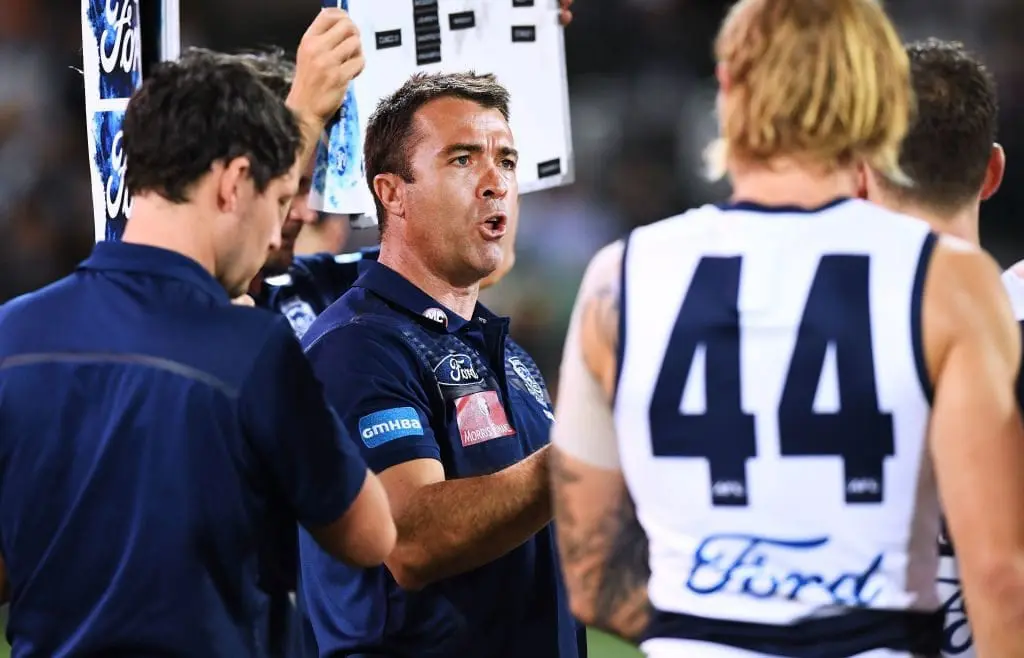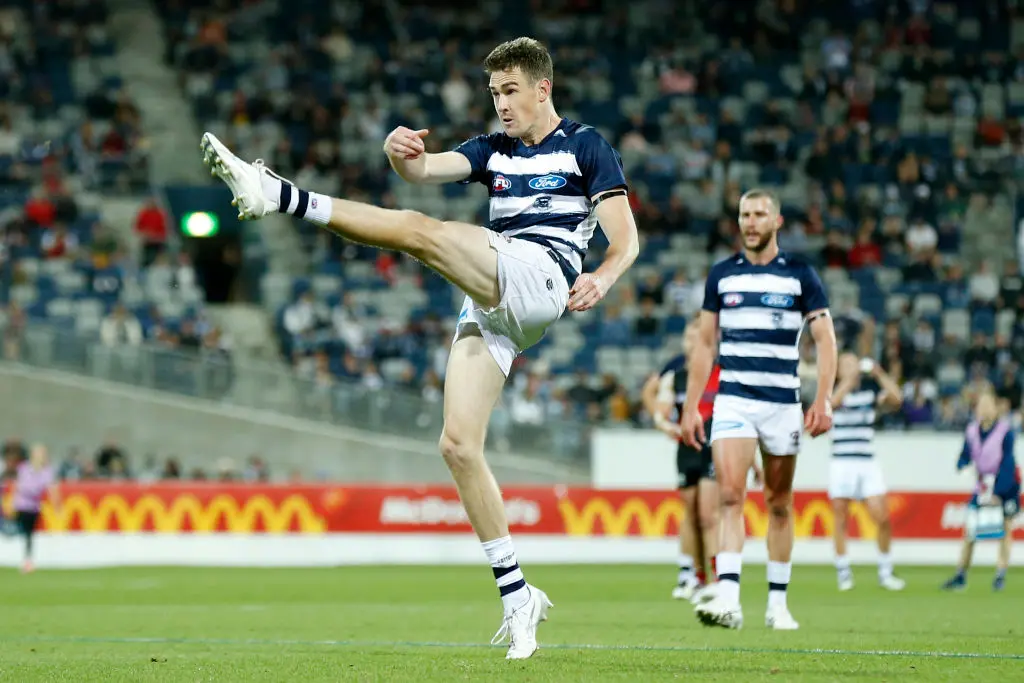Geelong enter 2022 after another strong but ultimately disappointing season.
The Cats boast a strong and talented list that should contend again this season, but can they go one further and win the flag? That remains to be seen.
Chris Scott's men have finished the regular season in the top four in five of the past six seasons, highlighting their consistency and high performance.
However, they have only made the grand final once in that six-year period, and Chris Scott's finals record since winning the flag in his first season in 2011 is a poor 6-13.
The Cats will enter 2022 with the oldest and most experienced list, but with players such as Patrick Dangerfield, Tom Hawkins, Tom Stewart and Jeremy Cameron still around, they're still in a good position to contend for a premiership.
With Scott entering the last year of his contract, there will be added pressure on him to not only lead his team to the finals, but to perform well in those finals also.
With areas that need to be addressed for the Cats, here are the five burning questions for the Geelong Cats heading into season 2022.
Can Geelong's ageing list still hold up against the best sides?
As mentioned before, Geelong have the oldest list with an average of 25.7 years of age across the playing group, and subsequently, the most experienced list with an average of 96.6 games played.
Whilst experience is usually a positive asset, it can also leave the playing list very top-heavy with 11 players aboce the age of 30, and not many promising young players coming through the ranks to spark the next generation at Kardinia Park.
The Cats have continually invested in the present rather than the future, with the nine oldest lineups in VFL/AFL history coming from Geelong in the past two seasons.

It is a trend that has seen the Cats stay up the top end of the ladder, but with no flags to show for it in recent years, a change in age demographic or playing style may be in need to contend once again when it matters most.
If we look at the experience of both grand finalists last season, Melbourne had an average of 71.4 games played across their playing group, and the Western Bulldogs an average of 72.4 games played.
Both teams have a good mix of experience and youth coming through, which proved to be a good recipe for both sides, whereas the Cats list shows majority experience and not much youth.
The Cats however did draft 18-year-old ruckman Toby Conway and 19-year-old midfielder Mitchell Knevitt, both from Geelong, who could get opportunities and help even out the experience with some youth in the side.
Geelong would be the oldest team in history to win a premiership if they can claim the flag in 2022, and Chris Scott will be desperate to prove the doubters wrong.
Can Geelong overcome their poor finals record?
It has been a worrying trend for Chris Scott's side in recent seasons with consistent strong regular season form and consistent underwhelming finals campaigns.
Six wins and 13 losses is not a flattering stat line for Geelong's finals games under Chris Scott since the end of the 2011 season.
Geelong's slow playing style of chipping the ball around and maintaining possession works well in the regular season where they can wear down the opposition, especially against the weaker teams.
This style however hasn't panned out well for the Cats when it comes to finals time, as finals games are a lot more frantic, fast-paced and less controlled, the way Geelong like it.

A shift in playing style could be the way to go in order to ensure that when Geelong hit the finals, they're confident that their playing style can hold up against the best teams, because recent finals form does not bode well for them.
All eyes will be on Geelong this season to see if they can turn their finals form around, as they definitely still have the talent to do so.
Is there too much reliance on Tom Stewart down back?
Tom Stewart is one of the best defenders in the competition, with his intercepting ability, strong overhead marking, one-on-one defending and rebounding the ball from the defensive 50 offering plenty for the Cats down back.
However, when Stewart went down late in 2021, it exposed Geelong's defence in the finals.
The All-Australian defender missed the Cats final five games of last season due to a Lisfranc fracture in his foot, with Cats losing three of those five games including two big finals losses to Port Adelaide and eventual premiers in Melbourne.

Not all can be blamed on the absence of Tom Stewart, but the star Cat is arguably Geelong's most influential player with his defensive abilities and attacking play so pivotal to Scott's game style.
Geelong pride themselves on defence, with the Cats conceding the second least amount of points up until Stewart's injury.
After that, Geelong were outscored by a whopping 126 points across their two finals losses, which included giving up 125 points in the biggest game of their season to Melbourne.
Jack Henry did a solid job trying to fill the hole that Stewart left, but with the retirement of Lachie Henderson, and the tendencies for Mark Blicavs to move up the field onto the wing and into the ruck, it leaves a heavy reliance on Stewart in the backline, which is something that should be addressed heading into 2022.
Can Geelong's tall forwards stay fit?
Geelong have a formidable forward line highlighted by the twin towers that is Tom Hawkins and Jeremy Cameron.
When these two link up alongside Esava Ratugolea and Gary Rohan, they are hard to stop, but the problem is whether they can all be on the ground at the same time, due to their injury history.
Cameron has a history of soft tissue injuries, which led to a hamstring injury and several weeks on the sidelines last season.

kicks for goal during the AFL Community Series match between the Geelong Cats and the Essendon Bombers at GMHBA Stadium on March 06, 2021 in Geelong, Australia. (Photo by Darrian Traynor/Getty Images)
Rohan injured his hamstring in the preliminary final against Melbourne, being subbed out of the game at half-time and also has a bad injury history including a nasty broken leg in his past life as a Swan.
Ratugolea suffered a broken ankle in 2018 but has had a pretty solid run with injury since, and Hawkins turns 34 next season, in which hopefully his big frame will continue to hold up.
If all these forwards can get on the park at the same time, then they usually put in a strong performance, but the question remains if all of them can stay healthy heading into the 2022 season.
What is a pass mark for 2022?
Scott is now entering the final year of his contract and is under increasing pressure to perform and bring home another premiership to Kardinia Park.
Scott was reportedly set to sign on at the club last October that would see him as head coach until the end of the 2024 season, but nothing has officially been announced by the club since those reports surfaced.
The Cats have seen a multitude of changes in their coaching and front office department with assistants Matthew Scarlett, Corey Enright and Matthew Knights departing as well as CEO Brian Cook.
Recently retired Eddie Betts and former premiership Cat James Kelly have since joined the coaching ranks, whilst former AFL Football Operations boss Steve Hocking has taken over as CEO from Cook.

Hocking had a strong stance when asked if Chris Scott will be granted a contract extension beyond the 2022 season, backing in the current head coach.
"He will be extended. There is a contract in place for 2022 but we are committed to Chris," Hocking said last year.
With the pressure mounting on Scott to deliver from the external public, and Hocking declaring he will coach beyond 2022, the question becomes what is a pass mark for Chris Scott to ensure he is granted a contract extension beyond 2022?
Scott will have to reinvent and tweak his game style to prove to the board and the supporters that Geelong can go all the way under his guidance, but only time will tell for Scott and the Cats.






